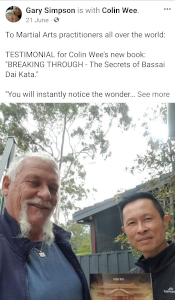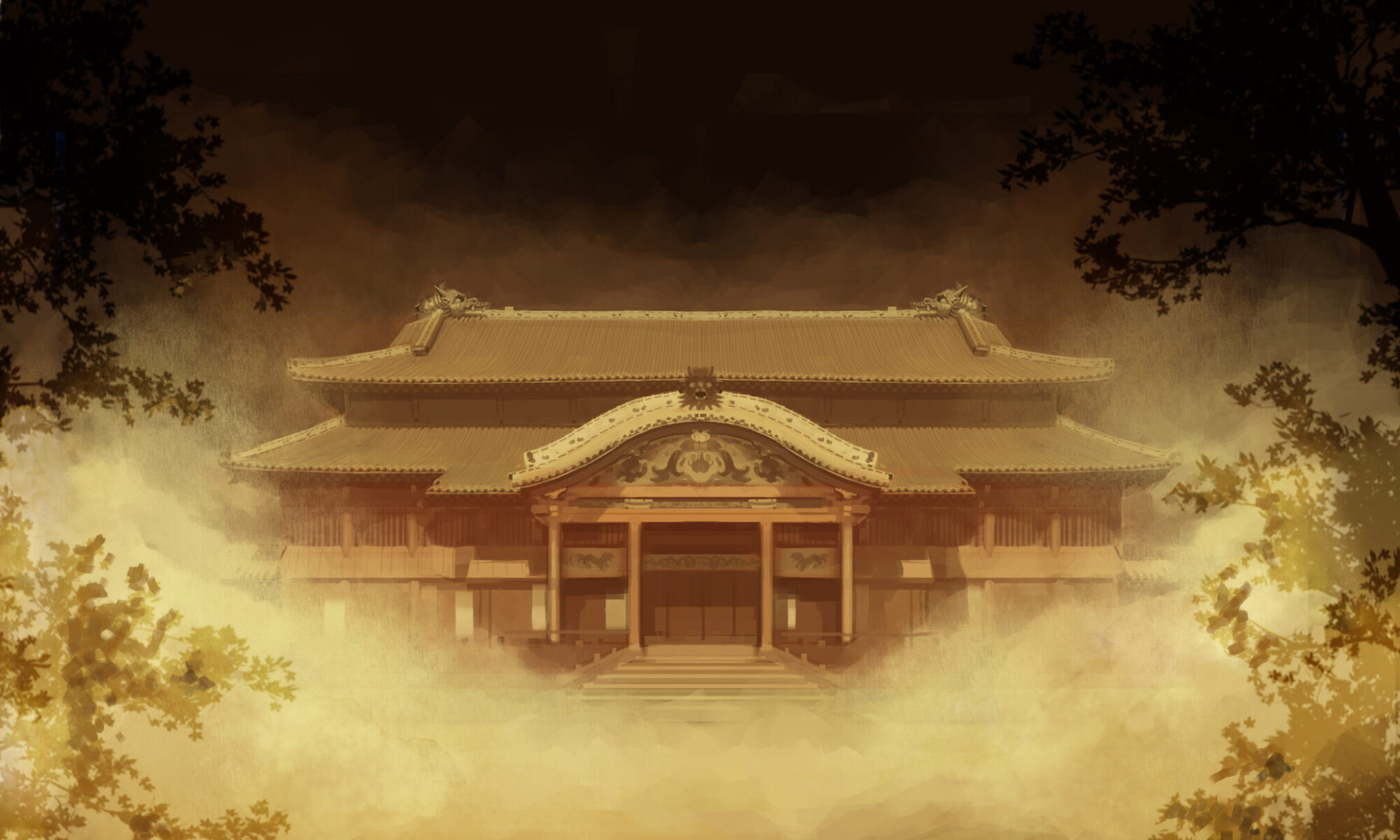

21 June 2023: Hanshi Gary Simpson, Zanshin Kai
To Martial Arts practitioners all over the world:
TESTIMONIAL for Colin Wee’s new book: “BREAKING THROUGH – The Secrets of Bassai Dai Kata.
You will instantly notice the wonderful cover of this book. This continues inside the covers. The author, who is a friend of mine and a close martial arts acquaintance of some 10-15 years now, has done a brilliant job of dissecting this kata.
Bassai Dai is well-known to me, having practiced it for some 45+ years myself. Colin’s interpretations are different to mine but that doesn’t matter – we are all different. What matters is the analysis – the thinking of what is BEHIND the meaning of the kata. This is how we personalize our karate at the senior level.
Colin and his assistant, Joshua Lay, have done a masterful job of capturing the essence of this mainstream kata. To me, the brilliance of what they have done is in the breakdown (bunkai) and then the application (oyo).
This book can be used as a guide to analyzing any kata in your own system. In other words, get the book and see HOW to do it for yourself in your own martial arts style.
Beautiful, professional presentation. I am very pleased to be able to have this book in my collection of over 250 books on all styles of martial arts.
I thoroughly recommend this book to my fellow martial artists.
Gary Simpson
Hanshi, 9th Dan
Zanshin Kai Karate Do and Kobudo
29 June 2023: Sensei Andreas Louca, JKA Karate Cyprus
Shotokan Karate Portal Book Review No. 32: Bassai Dai is a difficult Kata, not only does it have many moves, but they are also much more advanced, compared to the ones found in the Heian and Tekki series (usually the curriculum Kata before Bassai is taught). As a result, most Karateka see it as the “Wave-breaker” which sorts the ones who will quit before ever reaching the brown belt, let alone the coveted black belt. In other martial arts, it is also a Kata of great importance (the form varies through styles but has the same general look), as we will see in Sensei Colin Wee’s book “Bassai Dai – Breaking Through – The secrets of Bassai Dai Kata” (Moosul Publishing – 2023).
The book has a foreword by Grand Master Keith Yates, which includes an interesting parallel drawn between Kata and sewing, adding that the word Kata can be translated as a “shape” form like a dress. The book continues with a presentation of A.K.A.T.O. (American Karate and Tae Kwon Do Organisation), its lineage and founder. Furthermore, the author’s own school of Joong do Kwan (School of the middle method) is presented and its history.
The influence of the internet in martial arts is mentioned which is both positive and negative. The 3K method (Kihon-Kata-Kumite) is praised for its merits and criticised for its rigidness. The author explains how his own teaching was formed and changed based on this method.
The book continues with an overview of Bassai Dai and its applications, which will be the main part of it. It goes through the terms of Bunkai, Oyo, Embusen, and Shuhari, all the way to how to deconstruct a Kata and get the most from its essence and unique form. In other words, to enter the same flow state that one attains after several Kumite exchanges but through Kata.
Additionally, making the Kata useful is stressed in the book. Becoming proficient with performing a Kata but being unable to fight with it loses the point. The book describes twelve applications from Bassai Dai, which are presented in depth through text and pictures. Each application has its separate title and overview, making it distinct from the rest. The author feels that Kata must be seen both as a whole and as each of its individual moves. After all, if we were to use a Kata move in the street, we would not continue the Kata to its conclusion as the circumstances would differ each time. The applications themselves are not simple Bunkai, in terms of receiving an attack and unleashing a counter, but rather a series of moves which might end up with throwing, grappling or using an opponent as a human shield against other adversaries. At the end of each application chapter there are key points, marked as “Important observations”. Lastly, there are questions presented by the author, that the reader can answer on fighting tactics and self-defence.
Attack angles, the opponent’s mindset, points of contact and distance are all seen through the prism of the Kata application. One can see how much can be taught by studying Kata with the desired depth as opposed to choreography to win competitions. The consequences of strikes at certain parts of the human anatomy (not valid targets in sport version of martial arts) are also presented along the way. Lines from Kung Fu to Aikido are shown to be within the Kata in modified forms. One of the most interesting points, often overlooked by many Senseis, is the contingency plan when an attack fails. This ensures a flow of attacks to happen without a mental block after an initial misfortune. If some series of moves have failed, counter-attack by adjusting to the opponent’s new move.
The coloured pictures of the book are not particularly large but are nevertheless clear and you can understand what is needed of you. Each comes with a small text describing the move at that point. The applications should be practised by experienced martial artists rather than novices as some have feints to the eyeballs or joint manipulation that could lead to accidents if one is not cautious. The book ends with an interview given to “Totally Tae Kwon Do” magazine by the author in 2018, this way the reader can get to know him as a person, rather than just his teaching methods. Overall, the book is a very good choice for an experienced martial artist who want to go deeper into one of the most important Kata.
Sensei Andreas Louca
JKA Karate Cyprus – Shotokan Karate Portal


